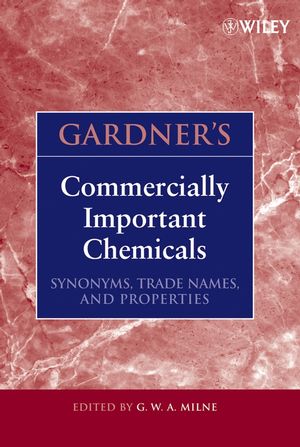Gardner's Commercially Important Chemicals: Synonyms, Trade Names, and PropertiesISBN: 978-0-471-73518-2
Hardcover
1216 pages
July 2005
 Other Available Formats: E-book
|
||||||
An exhaustive resource for the industrial chemical community
Through eleven editions, Gardner's Chemical Synonyms and Trade Names has become the best-known and most widely used source of information on chemicals in commerce. This companion book reflects the continuing research underlying Gardner's and presents a major expansion of the information provided for individual chemical compounds.
Gardner's Commercially Important Chemicals: Synonyms, Trade Names, and Properties:
* Contains 4,174 chemical entries and information such as structure, molecular formula, and chemical name
* Includes synonyms for each chemical, including other identifiers, chemical names, trade names, and trivial names, in English and other languages
* Provides chemical properties of the compounds, information concerning known uses of the chemical and biological data-in particular, acute toxicity in various species, where available
* Lists the companies that manufacture or supply the listed chemicals
* Describes bulk inorganic chemicals, major pesticides (herbicides, insecticides, antifungal agents, etc.), and many dyestuffs, surfactants, and metals, along with the most commonly used drugs
* Contains indexes by chemical name and synonym, Chemical Abstracts Service (CAS) Registry Numbers, and EINECS (European Inventory of Existing Commercial Substances) numbers
One useful feature of this database is the inclusion of physical properties and use data for pure chemicals. Properties that have been provided, when available, include: the melting point, boiling point, density or specific gravity, optical rotation, ultraviolet absorption, solubility, and acute toxicity. The major uses of most of the chemicals are indicated and, where appropriate, regulatory information is also provided.
Through eleven editions, Gardner's Chemical Synonyms and Trade Names has become the best-known and most widely used source of information on chemicals in commerce. This companion book reflects the continuing research underlying Gardner's and presents a major expansion of the information provided for individual chemical compounds.
Gardner's Commercially Important Chemicals: Synonyms, Trade Names, and Properties:
* Contains 4,174 chemical entries and information such as structure, molecular formula, and chemical name
* Includes synonyms for each chemical, including other identifiers, chemical names, trade names, and trivial names, in English and other languages
* Provides chemical properties of the compounds, information concerning known uses of the chemical and biological data-in particular, acute toxicity in various species, where available
* Lists the companies that manufacture or supply the listed chemicals
* Describes bulk inorganic chemicals, major pesticides (herbicides, insecticides, antifungal agents, etc.), and many dyestuffs, surfactants, and metals, along with the most commonly used drugs
* Contains indexes by chemical name and synonym, Chemical Abstracts Service (CAS) Registry Numbers, and EINECS (European Inventory of Existing Commercial Substances) numbers
One useful feature of this database is the inclusion of physical properties and use data for pure chemicals. Properties that have been provided, when available, include: the melting point, boiling point, density or specific gravity, optical rotation, ultraviolet absorption, solubility, and acute toxicity. The major uses of most of the chemicals are indicated and, where appropriate, regulatory information is also provided.



